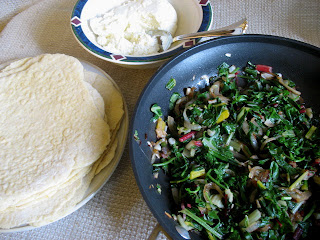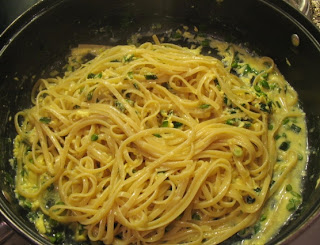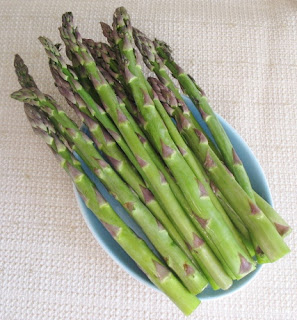If I were an artist, this time of year would have to be characterized as my “Green Period.” It seems that nearly everything seasonal that I have to cook with, especially if it comes in our CSA box, is green. It’s easier to list the exceptions: strawberries, radishes, a few hot-house tomatoes, the white parts of scallions, a few chard stems…you get the idea.
And so I set out to try a recipe I had put aside for when such green things were back in abundance, one for tacos made with Swiss chard cooked with onions and garlic. Now, usually I forgo publishing a recipe that didn’t live up to my unreasonably high expectations, or that I just found only so-so. In this case, while I did find my attempt at this dish only so-so, I love the idea of the dish, the theory, the method, the very lifestyle of it. I want to, again and again, eat sautéed greens wrapped in tortillas. I want you to want to, too.
You see, I had a memory of some delicious sautéed greens with lots of garlic and perhaps some vinegar that I had made as a side dish at least a year ago. That’s what I wanted in my tacos. Earthy greens, really garlicky, a little salty. I added to that memory of flavor with a big handful of cilantro, a bit of chile pepper, and a splash of lime juice. Somehow, however, I missed my imagined mark.
These tacos weren’t bad, of course. Since I sautéed my chard instead of boiling it, it maintained its character and avoided that canned spinach pitfall, the risk of which boiled green are always running. (The original recipe called for boiled chard.) I just wanted more garlic, chile, lime, cilantro, and, okay I’ll admit it, salt flavor. Perhaps in a second run at this recipe I’d be more extreme, but I’m going to print it as I made it, knowing that it really was pretty good. Good enough to make again. Good enough to promote the idea of stuffing tacos with sautéed greens forevermore.
I also garnished the greens in these tacos with some homemade fresh cheese, from How to Cook Everything Vegetarian by Mark Bittman. I used the same ingredients and technique as I did for the cottage cheese in this post, but drained off more of the whey and squeezed the fresh curds into a drier cheese. It went quite nicely with the sautéed greens on my taco. So did the tortillas I made (I’m more excited about the tortillas than about the rest of the taco). More on those tortillas in another post.
These tacos weren’t bad, of course. Since I sautéed my chard instead of boiling it, it maintained its character and avoided that canned spinach pitfall, the risk of which boiled green are always running. (The original recipe called for boiled chard.) I just wanted more garlic, chile, lime, cilantro, and, okay I’ll admit it, salt flavor. Perhaps in a second run at this recipe I’d be more extreme, but I’m going to print it as I made it, knowing that it really was pretty good. Good enough to make again. Good enough to promote the idea of stuffing tacos with sautéed greens forevermore.
I also garnished the greens in these tacos with some homemade fresh cheese, from How to Cook Everything Vegetarian by Mark Bittman. I used the same ingredients and technique as I did for the cottage cheese in this post, but drained off more of the whey and squeezed the fresh curds into a drier cheese. It went quite nicely with the sautéed greens on my taco. So did the tortillas I made (I’m more excited about the tortillas than about the rest of the taco). More on those tortillas in another post.
So, I say enjoy your own little Green Period if you’re going through one now in your refrigerator or garden or farmer’s market or CSA box. And put some green things in your tacos!
Tacos with Sauteed Greens and Fresh Cheese
Based on a recipe in Martha Stewart Living magazine
I like to include the stems with the sautéed chard. Just finely chop the stems before cooking.
1 tablespoon olive oil or vegetable oil
1 small yellow or white onion, halved and thinly sliced
2 garlic cloves or 2 heads green garlic, finely chopped
1 tablespoon minced fresh chile pepper (or to taste)
6 ounces chard (or other dark greens), chopped
2 tablespoons water
¼ teaspoon coarse salt (or more to taste)
1 cup cilantro leaves and tender stems, chopped
1 tablespoon lime juice
fresh cheese and flour or corn tortillas for serving
1. Heat the oil in a large skillet over medium heat. Add the onion and cook for about 5 minutes, or until soft and beginning to brown, stirring frequently. Add the garlic and chile and cook about 1 minute more, stirring constantly.
2. Add the chard, water and salt and cook 2-3 minutes, stirring frequently, until the chard is tender and well wilted. Add the cilantro and cook until the cilantro has wilted.
3. Add the lime juice and cook until most of the liquid has evaporated. Taste for seasoning and adjust if necessary. Serve with fresh cheese on tortillas
Makes about 2 servings. This recipe can be doubled.
Other recipes like this one: Chard Tart with Feta Cheese and Olives, Chard Soup with Cilantro and Lime, Pasta with Kale, Summer Squash, Olives and Feta Cheese




































